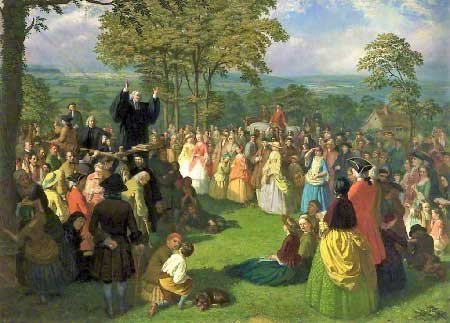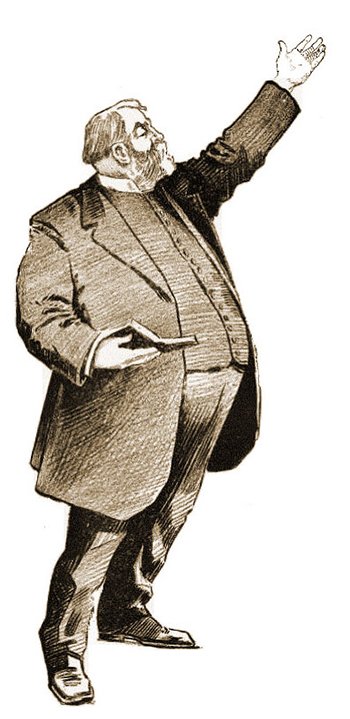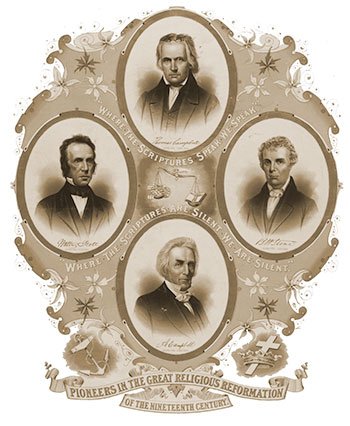The Boston Revival of 1740:
A City Ablaze

Whitefield preaching in the open air
The Boston Revival of 1740 was a pivotal moment in the spiritual history of colonial America. This article delves into the historical context, key figures, and lasting impact of this revival, shedding light on its antecedents, unique characteristics, and its place within the broader Great Awakening.
State of Religion in Boston Prior to 1740
Before the fervor of the 1740 revival, Boston’s religious climate was characterized by a blend of established traditions and growing diversity. The city was primarily Congregationalist, with five prominent churches led by influential figures like Increase and Cotton Mather at the Old North Church, and Thomas Prince and Joseph Sewall at the Old South Church. While Puritanism remained a strong influence, other denominations, such as Baptists and Episcopalians, were beginning to establish a presence 1.
However, a sense of spiritual complacency and decline in religious enthusiasm had settled over the city 2. This decline was observed in relaxed church membership practices and a decrease in “godliness” among young people. Despite the strong presence of religion in daily life, some inhabitants noted a lack of commitment and genuine piety 3. Adding to this decline were trends of “arid rationalism” and “formalism in liturgical practices” that further contributed to a sense of spiritual dryness 4.
Antecedents and Early Revivals
The 1740 revival was not an isolated event but rather the culmination of several earlier attempts to rekindle spiritual fervour in Boston. In 1721, concerned by the decline in piety among youth, eight ministers united to preach a series of sermons. This effort, however, was soon followed by a devastating smallpox epidemic that claimed the lives of many young people. Despite the tragedy, the desired spiritual awakening did not fully materialize. Subsequent efforts in 1722, focused on prayer and fasting for an outpouring of the Holy Spirit, and in 1726, promoting Bible reading and prayer in homes, also failed to produce lasting results.
A notable precursor to the 1740 revival was the Northampton revival of 1735, led by Jonathan Edwards. This revival, characterized by intense spiritual experiences and conversions, spread to neighbouring congregations and foreshadowed the larger awakening to come.
The Spark that Ignited the Flame
The arrival of George Whitefield in September 1740 proved to be the catalyst for the Boston Revival. Whitefield, a charismatic itinerant preacher from England, captivated audiences with his powerful sermons. His preaching at the Brattle Street Church drew an estimated 3,000 people, and he later preached to even larger crowds on Boston Common. Whitefield’s message connected with the spiritual hunger of the people, and his ministry marked the beginning of a widespread revival in the city.
Key Leaders and Their Roles
While George Whitefield played a pivotal role in igniting the revival, other figures contributed significantly to its impact and spread. Thomas Prince, co-pastor of the Old South Church, meticulously documented the events of the revival, providing valuable insights into its development and impact. Gilbert Tennent, another prominent revivalist, arrived in Boston in December 1740 and further intensified the movement with his fervent preaching.
Jonathan Edwards, though not directly involved in the Boston revival, profoundly influenced the theological underpinnings of the Great Awakening. His emphasis on personal religious experience, the sovereignty of God, and the necessity of the “new birth” shaped the revival’s message and impact 5. Edwards also stressed the importance of “inward feelings of the Spirit” as evidence of true faith, while cautioning against relying solely on outward religious practices 6.
Churches Involved
The Boston Revival was largely a trans-denominational movement, impacting various churches in the city. While Congregational churches were at the forefront, the revival also touched Presbyterian and Baptist congregations 4. The five main Congregational churches in Boston, including Old North Church, Old South Church, and Brattle Street Church, played significant roles in hosting revival meetings and supporting the movement.
Revival Experiences and Manifestations of the Holy Spirit
The Boston Revival was characterized by intense religious experiences and emotional expressions. Many people were deeply convicted of their sin and experienced profound conversions. Manifestations of the Holy Spirit were reported, including “outcries, faintings, convulsions” and overwhelming joy 7. These experiences, while sometimes viewed with skepticism, were seen by many as evidence of God’s powerful presence and the transforming work of the Holy Spirit.
Compared to other revivals of the time, the Boston Revival was marked by a unique intensity and a sense of collective spiritual awakening. While some revivals focused primarily on individual conversions, the Boston Revival fostered a sense of communal experience and a shared pursuit of spiritual renewal 7.
Prayer in the Boston Revival
Prayer played a central role in the Boston Revival, both in preparation for the awakening and in sustaining its momentum. The revival was preceded by several calls to prayer and fasting by Boston ministers, seeking God’s intervention and an outpouring of the Holy Spirit. Not least of all was the use of Jonathan Edwards During the revival itself, prayer meetings were held in churches, homes, and even open-air settings, reflecting the widespread desire for spiritual renewal and communion with God.
The prayers offered during the revival were often characterized by fervency, humility, and a deep longing for God’s presence. They reflected the spirit of the prophets, who “gave God no rest” and pleaded with Him for revival. These prayers were not merely formal recitations but expressions of genuine spiritual hunger and a desire for a deeper relationship with God.
Places of Prayer
Revival meetings took place in various locations throughout Boston. Churches, such as the Old North Church, served as central gathering places. Open-air meetings on Boston Common allowed for larger crowds to gather and hear the revivalist preachers 4. Homes also became places of prayer and spiritual reflection as the revival spread throughout the community 8. The use of diverse locations for prayer meetings reflects the pervasive nature of the revival and its impact on all aspects of community life.
Women in the Revival
Women played a significant role in the Boston Revival, actively participating in prayer meetings and contributing to the spiritual excitement of the movement. Daily prayer meetings were held by and for women, providing a space for spiritual expression and support 8. This involvement of women highlights the inclusive nature of the revival and its impact on different segments of society.
Impact on African Americans
The Boston Revival also had a significant impact on African Americans, both slaves and free blacks. The revival movement increased exposure to Christianity among this community, leading to conversions and a greater sense of spiritual identity 5. This impact reflects the trans-denominational and inclusive nature of the Great Awakening, which sought to reach people from all walks of life.
Divisions and Controversies
While the Boston Revival brought about spiritual renewal and unity, it also led to divisions and controversies within the religious landscape. The revival’s emphasis on emotional experiences and fervent preaching sparked opposition from those who favored a more traditional and intellectual approach to faith 9. This division led to the emergence of “New Lights,” who embraced the revival’s message and methods, and “Old Lights,” who resisted the new wave of religious enthusiasm.
Immediate and Lasting Results
The Boston Revival had both immediate and long-term effects on the city and its religious landscape. In the short term, there was a marked increase in religious enthusiasm, church attendance, and conversions. The revival fostered a sense of unity among different denominations and led to the formation of prayer groups and religious societies.
The revival’s lasting impact included a renewed emphasis on personal piety, a greater awareness of social issues, and the growth of new religious institutions. The Great Awakening, of which the Boston Revival was a part, contributed to the rise of evangelicalism and influenced the development of American religious thought and culture.
Number of Converts
While precise figures are difficult to ascertain, historical accounts suggest that a significant number of people were converted during the Boston Revival. Some estimates conclude that in New England alone, 10% of the population, (approximately 30,000 people) were added to churches between 1740 and 1742. Others take a more general view, stating that the number of people converted in that period numbered between 25-50,000. Certainly, George Whitefield’s ministry is credited with contributing to a large portion of these conversions.
Context and Relationship to the Great Awakening
The Boston Revival was an integral part of the First Great Awakening, a widespread religious revival that swept through the American colonies in the 1730s and 1740s. The Great Awakening was characterized by passionate preaching, dynamic religious experiences, and an emphasis on personal conversion 4. The Boston Revival, with its focus on spiritual renewal and the experience of God’s presence, exemplified the key characteristics of this larger movement.
Key Takeaways
The Boston Revival of 1740 offers valuable lessons for understanding the dynamics of religious awakenings and their impact on individuals and communities. Some key takeaways include:
- The Importance of Prayer: The revival was preceded and sustained by fervent prayer, highlighting the role of prayer in preparing hearts for spiritual awakening. The calls to prayer and fasting by Boston ministers demonstrate the significance of seeking God’s intervention and guidance in times of spiritual decline.
- The Power of Preaching: The passionate and convicting preaching of figures like Whitefield and Tennent played a crucial role in igniting and spreading the revival. Their messages resonated with the spiritual hunger of the people and challenged them to embrace a deeper commitment to their faith.
- The Role of the Holy Spirit: The revival was marked by manifestations of the Holy Spirit, emphasizing the importance of spiritual experience and the transforming power of God. The emotional expressions and conversions witnessed during the revival were seen as evidence of the Holy Spirit’s work in individuals and communities 7.
- The Impact on Society: The revival had a profound impact on Boston society, leading to increased religious fervor, social reforms, and the growth of new religious institutions. The revival’s emphasis on personal piety and social responsibility contributed to a greater awareness of social issues and a desire for positive change 4.
Conclusion
The Boston Revival of 1740 stands as a testament to the enduring power of Christian revivals. It was a time of intense spiritual passion, marked by conversions, divine experiences, and a renewed focus on personal piety. This revival, as part of the larger Great Awakening, played a significant role in shaping the religious landscape of colonial America and left a lasting legacy on American religious thought and culture.
The Boston Revival was not merely a local phenomenon but a microcosm of the broader transformations taking place in American society during the 18th century. It reflected the growing dissatisfaction with established religious structures and a yearning for a more personal and experiential faith. The revival’s emphasis on individual piety and heart-felt engagement contributed to the rise of evangelicalism and laid the groundwork for future religious movements in America. The Boston Revival, therefore, serves as a window into the evolving religious landscape of colonial America and its implications for the development of American identity and culture 4.
Chronological Timeline
| Date | Event | Key Figure(s) |
| Spring 1721 | Series of sermons addressing decline in godliness among youth | Eight Boston ministers |
| Spring 1721 | Smallpox epidemic | N/A |
| Spring 1722 | Day of prayer and fasting for outpouring of the Holy Spirit | Boston pastors |
| Spring 1726 | Special sermons on Bible reading and prayer in homes | Boston pastors |
| October 1727 | Unpremeditated movement of the Holy Spirit | N/A |
| 1735 | Northampton Revival | Jonathan Edwards |
| September 1740 | George Whitefield arrives in Boston and preaches at Brattle Street Church | George Whitefield |
| December 1740 | Gilbert Tennent arrives in Boston | Gilbert Tennent |
| March 2, 1741 | Gilbert Tennent preaches farewell sermon | Gilbert Tennent |
Works cited
- Christianity in Boston | The Pluralism Project, accessed on December 14, 2024, https://pluralism.org/christianity-in-boston
- The Progression of Religions in First Church Boston, accessed on December 14, 2024, http://www.firstchurchbostonhistory.org/progressionofreligionsinfcb.html
- Religion in Colonial America: Trends, Regulations, and Beliefs | Facing History & Ourselves, accessed on December 14, 2024, https://www.facinghistory.org/resource-library/religion-colonial-america-trends-regulations-beliefs
- Great Awakening | Definition, Summary, Key Figures, Significance, Effects, & Facts, accessed on December 14, 2024, https://www.britannica.com/event/Great-Awakening
- First Great Awakening – Wikipedia, accessed on December 14, 2024, https://en.wikipedia.org/wiki/First_Great_Awakening
- Overview of the Great Awakening U.S. Religious Revival – ThoughtCo, accessed on December 14, 2024, https://www.thoughtco.com/great-awakening-of-early-18th-century-104594
- The Spirit of Revival | Sequoia Church, accessed on December 14, 2024, https://sequoiachurch.org/blog/2023/03/09/the-spirit-of-revival
- History of Revivalism in Boston – Emmanuel Gospel Center, accessed on December 14, 2024, https://www.egc.org/blog-2/2017/5/9/history-of-revivalism-in-boston
- The First Great Awakening, Divining America, TeacherServe®, National Humanities Center, accessed on December 14, 2024, https://nationalhumanitiescenter.org/tserve/eighteen/ekeyinfo/grawaken.htm
For further research
“An Appraisal of the Great Awakening” | The Martin Luther King, Jr. Research and Education Institute, accessed on December 14, 2024, https://kinginstitute.stanford.edu/king-papers/documents/appraisal-great-awakening
Christian History Timeline: George Whitefield 1714-1770, accessed on December 14, 2024, https://christianhistoryinstitute.org/magazine/article/george-whitefield-timeline



